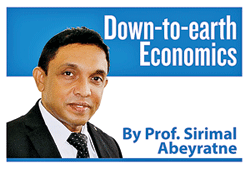Liberation day for Sri Lanka
View(s):“We Sri Lankans, have done more damage on our own exports than the potential impact by President Trump’s announcement of a 44 per cent reciprocal tariff on a quarter of total exports. Without such self-inflicted setbacks, we would not have been left with a mere US$12 billion in exports after four and a half decades of trade liberalisation. More importantly, we might have avoided even the economic crisis we face today.”
Reflecting on this issue now, in light of recent global developments—particularly the announcement of bilateral reciprocal tariffs by the US on Wednesday, April 2—I believe it is crucial to reassess our approach.

Coconut products for export. Sri Lanka needs to diversify its export base.
Vietnam’s response
China and Vietnam responded swiftly, yet they took distinctly different approaches. US had announced a 34 per cent tariff on imports from China and 46 per cent on imports from Vietnam.
In response, China retaliated by imposing the same 34 per cent against its imports from the US. However, Vietnam sought to dodge US tariffs on its exports to the US but wanted to cut down its tariffs on imports from the US to zero level. On Friday of the same week, US President Trump and Vietnam’s leader To Lam discussed the deal over the phone.
This is what the President Trump said after the discussion: “[I] just had a very productive call with To Lam, General Secretary of the Communist Party of Vietnam, who told me that Vietnam wants to cut their tariffs down to ZERO if they are able to make an agreement with the US. I thanked him on behalf of our country, and said I look forward to a meeting in the near future.”
Vietnam has established a low-tariff trade regime, with its Most Favoured Nation (MFN) average tariff rate standing at just 9.4 per cent. As of 2023, the country imposed an average tariff of 17.1 per cent on agricultural imports and 8.1 per cent on non-agricultural imports.
Since the late 1980s, Vietnam has pursued market-oriented policy reforms and developed a series of trade agreements with the US. These include a comprehensive trade agreement in 2001, a trade and investment framework agreement in 2007, and a partnership agreement in 2013.
Not a big deal!
 In 2024, Vietnam exported goods worth $137 billion to the US while its imports from the US totalled only $13 billion, resulting in a bilateral trade surplus of $124 billion in Vietnam’s favour. That is exactly why US reciprocal tariffs against Vietnam has come out as high as 46 per cent.
In 2024, Vietnam exported goods worth $137 billion to the US while its imports from the US totalled only $13 billion, resulting in a bilateral trade surplus of $124 billion in Vietnam’s favour. That is exactly why US reciprocal tariffs against Vietnam has come out as high as 46 per cent.
A reciprocal tariff of 46 per cent against Vietnam is deemed fair by the US President, with the expectation that it would eliminate the bilateral trade deficit. However, given Vietnam’s existing low-tariff trade regime, it is clear that tariffs are not the primary factor behind the trade imbalance with the US.
For Vietnam, however, reducing its tariffs to zero would not pose a significant challenge. With a strong 30-year track record of trade liberalisation, Vietnam has gained valuable insights into the benefits of lowering tariffs, which often outweigh potential drawbacks.
As a World Trade Organisation (WTO) member since 2007, Vietnam adheres to the Most Favoured Nation (MFN) principle. This principle mandates equal and fair treatment for all trading partners, ensuring non-discrimination and granting the same favorable trade terms to every nation.
If Vietnam were to implement zero tariffs across the board for imports from all countries, it could evolve into a “Singapore-style” free trade economy within Southeast Asia, further solidifying its position in the global trade network.
Export performance
About 30 years ago, both Sri Lanka and Vietnam had export values below $5 billion. At the time, Sri Lanka’s export portfolio was largely dominated by manufactured goods, while Vietnam’s exports were still primarily agricultural.
Fast forward to 2024, and Sri Lanka’s exports have risen to $12.8 billion, whereas Vietnam’s exports have surged to an impressive $405 billion.
What went wrong in Sri Lanka? The key issue lies in a ‘growing policy bias against exports,’ which emerged after a period of remarkable success up until the 1990s. Over time, Sri Lanka shifted from export-oriented strategies to increasingly protectionist policies, hindering its export growth.
The groundwork for decline was already established in the 1980s by internal conflicts: – a war in the North that lasted until 2009 and another in the South that ended in 1990. The government’s focus on the “twin wars” and the resulting spike in military expenditures disrupted the country’s liberalisation efforts.
The introduction of tariffs, para-tariffs, non-tariff barriers, domestic taxes, special duties, and other restrictive policies made Sri Lanka an increasingly difficult place for businesses to operate. Foreign investors began steering clear of Sri Lanka, and export growth stagnated as a consequence.
Exports under protectionism
The most challenging period for Sri Lanka began after 2005, when the country shifted to a protectionist regime, further sidelining investment and export growth. The protective measures, when applied to imports, ultimately penalised the export trade.
How does protectionism hinder export growth? It discourages private investors from entering the market to establish globally competitive businesses. Protectionist policies make exporting costly and uncompetitive, leading businesses to prioritise the local market over international opportunities.
Consequently, countries with protectionist regimes fail to attract the investors needed to drive export growth. Instead, such policies benefit only a handful of local businesses focused on serving the small domestic market.
For large-scale global investors, a limited local market is unattractive, as they seek locations better suited for global business. Only businesses that are content with a small market and fear competition tend to remain under the shield of import protection.
Import protection is often regarded as an “implicit tax” on exports. As imports weaken under protective measures, maintaining a stable and flexible exchange rate becomes increasingly difficult. This results in exchange rate volatility and market intervention, further undermining export competitiveness.
The situation worsened when maturing foreign debt must be repaid in foreign currency. But there were insufficient foreign exchange earnings to convert “rupees into dollars.” Ultimately, this led to Sri Lanka’s declaration of debt default and the collapse of its economy.
An opportunity
Sri Lanka cannot sustain its IMF-supported recovery programme without robust export growth. The recent announcement of US reciprocal tariffs presents both a challenge and an opportunity. If embraced as an opportunity, Sri Lanka’s responsive policy measures could liberate its export sector from the constraints of protectionism, paving the way for enhanced competitiveness and growth in international markets.
Sri Lankan exports to the US would now face a 44 per cent tariff, significantly higher than the current rates of 5–15 per cent. Unlike Sri Lanka, the US operates without a complex and fragmented tariff regime.
A country cannot afford to keep its doors closed to others while expecting unrestricted access to their markets. Policies rooted in such hypocrisy are unsustainable and should be avoided. As the Sri Lankan experience demonstrates, protectionist measures often result in more harm than benefit.
In response to US reciprocal tariffs, Sri Lanka’s most viable option is to commit to a time-bound, gradual phasing out of its cumbersome and prohibitive tariff regime. Although the country may not be in a position to rapidly simplify its tariff structure—given setbacks in trade liberalisation and its ongoing economic recovery—this is an ideal moment to initiate the process.
Fiscal consolidation?
This raises an important question about fiscal consolidation: How can Sri Lanka manage its tax revenue while liberalising import trade? Does it not weaken the recovery programme? According to Budget 2025 estimates, the government plans to collect 14 per cent of its revenue from taxes on external trade.
Countries with a stronger export performance do not rely much on taxes on external trade for government revenue. They have achieved both better fiscal management and healthier budgetary outcomes. Sri Lanka can draw valuable lessons from these examples, where export performance and sound fiscal policies consistently go hand in hand.
(The writer is Emeritus Professor at the University of Colombo and Executive Director of the Centre for Poverty Analysis (CEPA) and can be reached at sirimal@econ.cmb.ac.lk and follow on Twitter @SirimalAshoka).
Hitad.lk has you covered with quality used or brand new cars for sale that are budget friendly yet reliable! Now is the time to sell your old ride for something more attractive to today's modern automotive market demands. Browse through our selection of affordable options now on Hitad.lk before deciding on what will work best for you!


